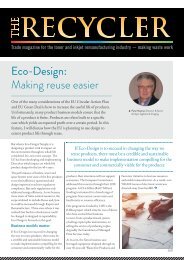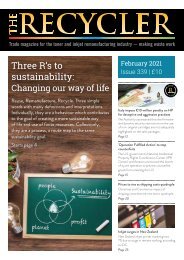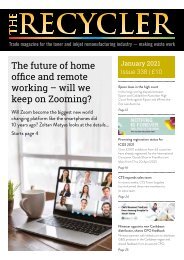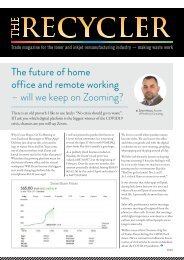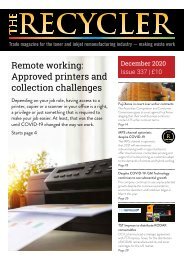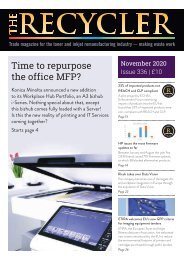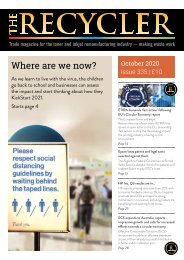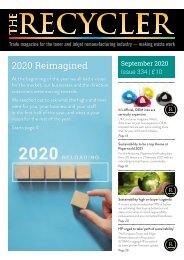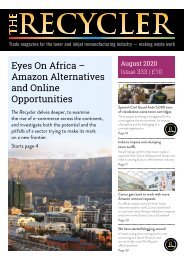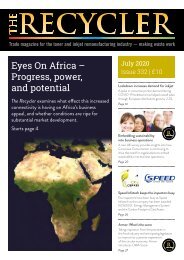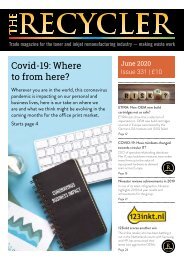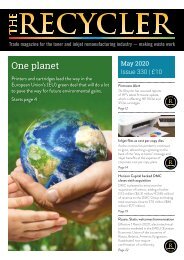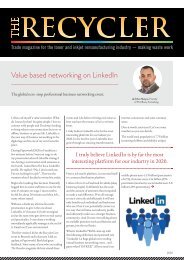The Recycler - Three Rs
Create successful ePaper yourself
Turn your PDF publications into a flip-book with our unique Google optimized e-Paper software.
<strong>The</strong> impact of WEEE<br />
and WEEE2<br />
Waste Electrical and Electronic Equipment<br />
is one of the largest sustainability problems<br />
facing the planet. In 2006 most EU states<br />
transposed the WEEE Directive and<br />
regulations into law. <strong>The</strong> regulations<br />
separated WEEE into two categories; first<br />
is WEEE placed on the market before<br />
2005 where the onus is on the owner to<br />
manage its recycling and second, WEEE<br />
produced later, where the producer and/or<br />
distributor has the collection and recycling<br />
responsibility.<br />
<strong>The</strong> 2014 WEEE 2 directive laid down<br />
certification criteria to demonstrate<br />
that companies are complying with the<br />
regulations. <strong>The</strong>se regulations provide<br />
frameworks for how end-of-use products<br />
are managed at the end of their lifecycle.<br />
<strong>The</strong>y also encourage recycling and reuse.<br />
<strong>The</strong> scope encompassing everything from<br />
household appliances to IT equipment<br />
to medical devices. Certification is now<br />
mandatory for many electronic devices.<br />
Non-compliance could result in an<br />
EU wide market bar. Pollution of the<br />
environment carries significant fines.<br />
<strong>The</strong>re are numerous takeback schemes<br />
in action today which vary depending<br />
upon whether we are discussing business<br />
or consumer WEEE. Revenue streams<br />
accompanying the WEEE also vary<br />
between B2B and B2C channels and EU<br />
countries. <strong>The</strong> B2C advice if the product<br />
features the WEEE symbol (see figure 2) is<br />
to check with the local authority, product<br />
manufacturer and distributor to establish<br />
the correct collection channel. In a B2B<br />
scenario, do not expect to take it to the<br />
local household recycling center, they are<br />
likely to turn you away.<br />
F.2 WEEE Symbol<br />
F.3 China Consumers Electronics Replacement Habits<br />
China has the lowest percentage of consumers replacing devices less frequently<br />
but the highest number of consumers who plan to implement<br />
100%<br />
75%<br />
50%<br />
25%<br />
0%<br />
US China India Germany<br />
Already replacing<br />
less frequently<br />
Letting go: Reuse in the<br />
ICT sector<br />
Some electronic products have a value that<br />
cannot be measured in financial terms only.<br />
Humans develop emotional attachments<br />
which means we habitually store products<br />
at the end of their life, rather than return or<br />
dispose of them into the WEEE stream.<br />
A study by Alphawise, the proprietary<br />
survey and data arm of Morgan Stanley<br />
Research found that almost 50% of<br />
consumers keep electronic devices that have<br />
stopped working. <strong>The</strong> study also found<br />
that trade-in and recycling is on the rise in<br />
the consumer market and, that almost 80%<br />
of respondents intend to either repair or,<br />
have repaired their devices in the next two<br />
years. A consequence is that consumers are<br />
extending the lifetime of devices and, 60%<br />
are buying new devices less frequently.<br />
<strong>The</strong> repair or replace conundrum<br />
varies around the world. Figure 3 shows<br />
consumers in China have been behind in<br />
replacing their devices less frequently than<br />
others but, 90% of Chinese respondents<br />
plan to slow their rate of replacement.<br />
Finally, the Alphawise study revealed<br />
that cash remains the greatest incentive<br />
to encourage consumers to trade-in. It is<br />
estimated that there are billions of Euros of<br />
older, serviceable mobile phones in homes.<br />
Most manufacturers offer a generous<br />
trade-in against new models but take-back<br />
is low. A quick and unscientific study of the<br />
Planning to replace<br />
less frequently<br />
UK<br />
No plans<br />
Source: Alphawise, Morgan Stanley Research<br />
author’s own home embarrassingly found<br />
four, old but usable mobiles.<br />
Getting this waste into reuse by<br />
remanufacturing before recycling is a<br />
problem. Numerous surveys demonstrate<br />
that consumers want to rethink their<br />
behaviour in a more sustainable way. One<br />
survey by Capgemini revealed that 79% of<br />
German buyers are ready to change.<br />
But how? <strong>The</strong> answer may come from<br />
an unlikely source, Value Added Tax<br />
(VAT). It has been suggested by several<br />
environmental groups including the Green<br />
Alliance, that reducing VAT on repairs<br />
would keep products in use for longer and<br />
create employment. Evidence from several<br />
EU country trials found encouraging<br />
results. In Sweden, when they reduced<br />
repair VAT, they countered the lost revenue<br />
with an increased tax on hazardous waste.<br />
It is possible that the problem is broader<br />
than motivation to reuse or recycle.<br />
Economically, there is a need to separate<br />
the use of resources from economic growth<br />
and, to separate environmental impact from<br />
resource use. But these are social norms<br />
which may take regional, and probably<br />
global events to spark change.<br />
Measuring progress is important and the<br />
EU has a target of collecting 65% of WEEE<br />
placed on the market. A target missed by<br />
the UK and many other member states in<br />
2018. Even defining the collection goals in<br />
measurable tonnage terms has been difficult<br />
to achieve.<br />
However you consume your news make sure you engage: Like, Follow and Share




